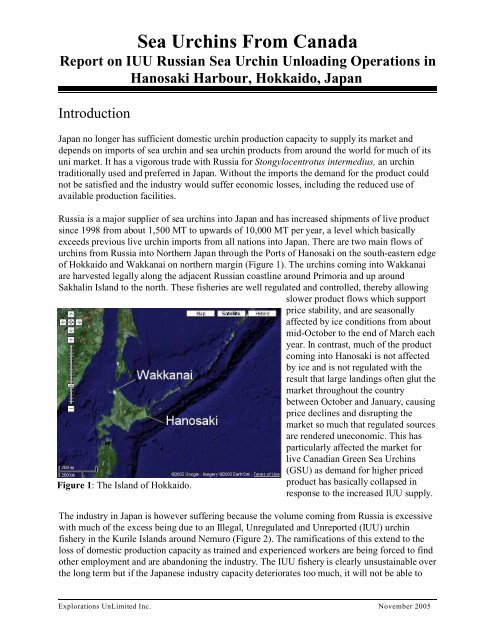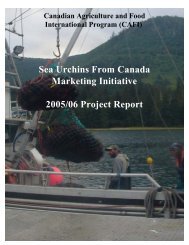Japan Trip 2005 Nemuro - Pacific Urchin Harvesters Association
Japan Trip 2005 Nemuro - Pacific Urchin Harvesters Association
Japan Trip 2005 Nemuro - Pacific Urchin Harvesters Association
You also want an ePaper? Increase the reach of your titles
YUMPU automatically turns print PDFs into web optimized ePapers that Google loves.
Sea <strong>Urchin</strong>s From Canada<br />
Report on IUU Russian Sea <strong>Urchin</strong> Unloading Operations in<br />
Hanosaki Harbour, Hokkaido, <strong>Japan</strong><br />
Introduction<br />
<strong>Japan</strong> no longer has sufficient domestic urchin production capacity to supply its market and<br />
depends on imports of sea urchin and sea urchin products from around the world for much of its<br />
uni market. It has a vigorous trade with Russia for Stongylocentrotus intermedius, an urchin<br />
traditionally used and preferred in <strong>Japan</strong>. Without the imports the demand for the product could<br />
not be satisfied and the industry would suffer economic losses, including the reduced use of<br />
available production facilities.<br />
Russia is a major supplier of sea urchins into <strong>Japan</strong> and has increased shipments of live product<br />
since 1998 from about 1,500 MT to upwards of 10,000 MT per year, a level which basically<br />
exceeds previous live urchin imports from all nations into <strong>Japan</strong>. There are two main flows of<br />
urchins from Russia into Northern <strong>Japan</strong> through the Ports of Hanosaki on the south-eastern edge<br />
of Hokkaido and Wakkanai on northern margin (Figure 1). The urchins coming into Wakkanai<br />
are harvested legally along the adjacent Russian coastline around Primoria and up around<br />
Sakhalin Island to the north. These fisheries are well regulated and controlled, thereby allowing<br />
slower product flows which support<br />
price stability, and are seasonally<br />
affected by ice conditions from about<br />
mid-October to the end of March each<br />
year. In contrast, much of the product<br />
coming into Hanosaki is not affected<br />
by ice and is not regulated with the<br />
result that large landings often glut the<br />
market throughout the country<br />
between October and January, causing<br />
price declines and disrupting the<br />
market so much that regulated sources<br />
are rendered uneconomic. This has<br />
particularly affected the market for<br />
live Canadian Green Sea <strong>Urchin</strong>s<br />
(GSU) as demand for higher priced<br />
Figure 1: The Island of Hokkaido.<br />
product has basically collapsed in<br />
response to the increased IUU supply.<br />
The industry in <strong>Japan</strong> is however suffering because the volume coming from Russia is excessive<br />
with much of the excess being due to an Illegal, Unregulated and Unreported (IUU) urchin<br />
fishery in the Kurile Islands around <strong>Nemuro</strong> (Figure 2). The ramifications of this extend to the<br />
loss of domestic production capacity as trained and experienced workers are being forced to find<br />
other employment and are abandoning the industry. The IUU fishery is clearly unsustainable over<br />
the long term but if the <strong>Japan</strong>ese industry capacity deteriorates too much, it will not be able to<br />
Explorations UnLimited Inc. November <strong>2005</strong>





